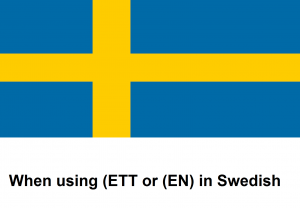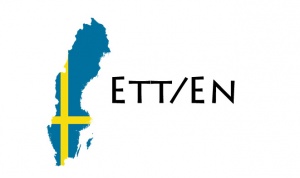Difference between revisions of "Language/Swedish/Grammar/When-use-Ett-or-En"
| Line 11: | Line 11: | ||
__TOC__ | __TOC__ | ||
==NOUN FORMS== | |||
===DEFINITE FORM=== | |||
When we want a noun to be in definite form we add a suffix to the noun; -en, -n or -et. | |||
For example: | |||
*<u>Ett</u> bord = Bord<u>et</u> | |||
*<u>En</u> hund = Hund<u>en</u> | |||
*<u>Ett</u> äpple = Äppl<u>et</u> | |||
*<u>En</u> skola = Skola<u>n</u> | |||
<blockquote>Here we just add -n since the word already ends with a vowel.</blockquote> | |||
As you might have noticed, you can know which suffix to use by looking at the indefinite article. | |||
*If it's an "En-word", the suffix is -en or -n. | |||
*If it's an "Ett-word", the suffix is -et. | |||
== | ===INDEFINITE FORM=== | ||
In Swedish, we have two words to choose when we want to write about nouns in an indefinite form: En or Ett. | In Swedish, we have two words to choose when we want to write about nouns in an indefinite form: En or Ett. | ||
| Line 27: | Line 43: | ||
This is not true. There is '''no grammatical rule''' to know when to use En or Ett, you just simply '''have to learn them'''. | This is not true. There is '''no grammatical rule''' to know when to use En or Ett, you just simply '''have to learn them'''. | ||
===DEFINITE FORM=== | |||
==GOOD NEWS: THERE ARE SOME GUIDELINES== | ==GOOD NEWS: THERE ARE SOME GUIDELINES== | ||
| Line 37: | Line 53: | ||
*Most of the nouns that end in -ande, -ende, -ek, -em, -iv, -um are ett nouns. Names of continents, countries, provinces, towns are ett nouns. | *Most of the nouns that end in -ande, -ende, -ek, -em, -iv, -um are ett nouns. Names of continents, countries, provinces, towns are ett nouns. | ||
== | == EXAMPLES (in several languages) == | ||
{| class="wikitable sortable" | {| class="wikitable sortable" | ||
|- | |- | ||
Revision as of 18:19, 8 September 2021
.
Hello everybody,
In today's lesson you will learn WHEN TO USE ETT & EN in Swedish.
Feel free to edit this page by adding new words and expressions !
Good learning ! :)
NOUN FORMS
DEFINITE FORM
When we want a noun to be in definite form we add a suffix to the noun; -en, -n or -et.
For example:
- Ett bord = Bordet
- En hund = Hunden
- Ett äpple = Äpplet
- En skola = Skolan
Here we just add -n since the word already ends with a vowel.
As you might have noticed, you can know which suffix to use by looking at the indefinite article.
- If it's an "En-word", the suffix is -en or -n.
- If it's an "Ett-word", the suffix is -et.
INDEFINITE FORM
In Swedish, we have two words to choose when we want to write about nouns in an indefinite form: En or Ett.
Examples:
- Ett bord = A table
- En hund = A dog
- Ett äpple = An apple
- En skola = A school
IS THERE A GRAMMATICAL RULE?
- En (Swedish article) = An (English article)
- Ett (Swedish article) = A (English article)
This is not true. There is no grammatical rule to know when to use En or Ett, you just simply have to learn them.
DEFINITE FORM
GOOD NEWS: THERE ARE SOME GUIDELINES
However, there are some guidelines that can help you to predict the gender.
- Most of the human beings and animals are en nouns. (Exceptions: ett barn, ett djur, ett bi, ett lejon ).
- Days, months, seasons are en nouns (Exception: ett dygn).
- Most of the nouns that end in -ad, -are, -dom, -else, -het, -ing, -ning, -ion, -ism, -lek, -nad, -or are en nouns.
- Most of the nouns that end in -ande, -ende, -ek, -em, -iv, -um are ett nouns. Names of continents, countries, provinces, towns are ett nouns.
EXAMPLES (in several languages)
| ENGLISH | SWEDISH | PRONUNCIATION IN
ENGLISH |
FRENCH | PORTUGUESE |
|---|---|---|---|---|
| A table | Ett bord | eht bohr | Une table | Uma mesa |
| A dog | En hund | ehn hoon | Un chien | Um cachorro |
| An apple | Ett äpple | eht eh pleh | Une pomme | Uma maçã |
| A school | En skola | ehn skoo lah | Une école | Uma escola |
| The table | Bordet | bohr deht | La table | A mesa |
| The dog | Hunden | hoon dehn | Le chien | O cachorro |
| The apple | Äpplet | eh pleht | La pomme | A maçã |
| The school | Skolan | skoh lahn | L'école | A escola |
Videos

